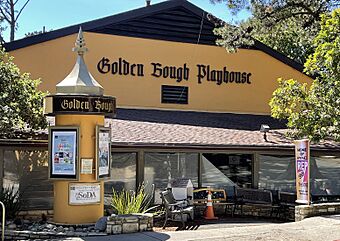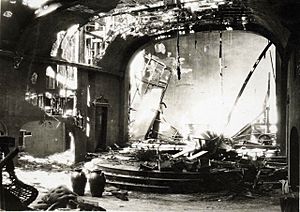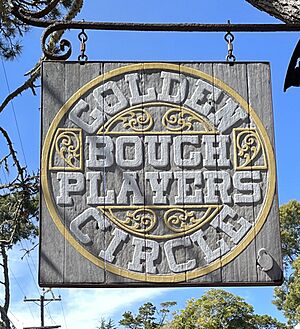Golden Bough Playhouse facts for kids

Golden Bough Playhouse, home of Pacific Repertory Theatre
|
|
| Former names | Arts and Crafts Hall, Abalone Theatre, Manzanita Theatre, Filmarte, Carmel Playhouse, Golden Bough Cinema |
|---|---|
| Address | Monte Verde Street |
| Location | Carmel-by-the-Sea, California, U.S. |
| Coordinates | 36°33′6.61″N 121°55′27.95″W / 36.5518361°N 121.9244306°W |
| Owner | Pacific Repertory Theatre |
| Type | Regional theatre |
| Capacity | Golden Bough Theatre: 297 Circle Theatre: 120 |
| Construction | |
| Built | 1952 |
| Architect | James Pruitt |
The Golden Bough Playhouse is a famous three-story theatre in Carmel-by-the-Sea, California. It's located on Monte Verde Street, between 8th and 9th Avenues. This playhouse stands where the first cultural center and theatre in Carmel once was. That first building was called the Carmel Arts and Crafts Club, built in 1906–1907.
Since 1994, the Pacific Repertory Theatre has owned and run the Golden Bough Playhouse. This group is the only professional theatre company in Monterey County that performs all year. The theatre has been updated in two main steps. The first part of the renovation started in 2011. The second part, which includes changes inside and outside, is planned for 2023-2024. The Golden Bough Playhouse was added to the National Register of Historic Places in 2002. It's an important historic building because it's on the site of Carmel's very first indoor performing arts places.
Contents
A Look Back: The Golden Bough Playhouse Story
The First Theatre: Carmel Arts and Crafts Club
In 1905, a group called the Carmel Arts and Crafts Club was started. Their goal was to help art grow in the village of Carmel-by-the-Sea. After the big 1906 San Francisco earthquake, many artists moved to Carmel to escape the damage. Famous writer Jack London even wrote about this artists' community in his book, The Valley of the Moon.
Early artists and writers, like Mary Hunter Austin, George Sterling, Robinson Jeffers, and Sinclair Lewis, took part in events at the club. Plays performed there became well-known across the country as early as 1914. One newspaper said that everyone in Carmel seemed to be excited about creating something new, especially with plays and art studios.
In 1906–07, the club built Carmel's very first cultural center and theatre. It was called The Carmel Arts and Crafts Clubhouse. Poets like Jane Austin and George Sterling put on their own "private theatricals" there. By 1913, the club began offering lessons for people who wanted to learn painting, acting, or crafts.
Some of the best painters in the United States, such as William Merritt Chase, taught classes there. The plays put on by the Arts and Crafts Club got a lot of attention. One magazine noted that "Probably no other women's club in the country has achieved a more remarkable success in the way of dramatic ventures."
In 1928, a local baseball and acting group called the Abalone League bought the Arts and Crafts Hall. They renamed it the Abalone Theatre. Later that year, Edward G. Kuster leased his own theatre, the Theatre of the Golden Bough, to a movie company. Kuster then went to Europe for a year to learn new theatre techniques. He also wanted to get rights to put on English and European plays in the United States.
In 1929, after returning from Europe, Edward G. "Ted" Kuster was approached by the Abalone League. They were having money problems and offered to sell him their theatre. This included the Carmel Arts and Crafts Club buildings. Kuster quickly accepted the offer. He then updated the building and renamed it the Studio Theatre of the Golden Bough. He moved all his shows, concerts, and lectures to this theatre on Monte Verde Street.
The First Golden Bough Theatre and Its Fire
Theatre became so popular in Carmel that between 1922 and 1924, two different indoor theatres were built. One was the Carmel Arts and Crafts Hall on Monte Verde Street. This building changed its name many times, including the Abalone Theatre and the Filmarte. The other was the first Theatre of the Golden Bough, built on Ocean Avenue.
This first "Golden Bough" theatre was designed and built by Ted Kuster. Kuster was a musician and lawyer from Los Angeles. He moved to Carmel to start his own theatre and school. Kuster rented out the Theatre of the Golden Bough to a movie theatre company for five years. He made sure they couldn't use the name "Golden Bough" for a movie house, so it was renamed the Carmel Theatre.
In 1935, Kuster made a new deal with the movie theatre. He wanted to put on a stage play one weekend each month. On May 17, 1935, he opened his play By Candlelight. But just two nights later, on May 19, the original Theatre of the Golden Bough was destroyed by fire. People thought someone might have started the fire on purpose. Kuster then moved his movie showings to the older building on Monte Verde Street. He renamed it the Filmarte. It became the first "art house" movie theatre between Los Angeles and San Francisco.
The Second Golden Bough and Its Rebirth
In 1940, Kuster came back to Carmel. The lease on the Monte Verde Street building had ended. He renamed it the Golden Bough Playhouse. He started showing plays, foreign films, and good American films all year round. For two summers, in 1940 and 1941, he also ran the Golden Bough School of Theatre.
In 1949, after putting on the play By Candlelight again, this second "Golden Bough" theatre also burned down. Again, people suspected that someone had started the fire on purpose. Kuster thought about building two new theatres. One would be a playhouse at the Monte Verde location. The other would be a movie theatre at the site of the original Golden Bough on Ocean Avenue.
In 1950, Kuster created a non-profit group to build a new theatre in the same spot. By 1952, he had successfully found almost 400 people to invest in the project. He raised $185,000, which was a lot of money back then. With these funds, Kuster built a facility with two theatres on the Monte Verde site.
The main theatre, called the Golden Bough Playhouse, faced Monte Verde Street. It had 330 seats and a large stage for both movies and live shows. Below the main stage, there was a smaller, cozy theatre with 125 seats. This was called the "Circle Theatre" and faced Casanova Street. The new Golden Bough Playhouse opened on October 2, 1952, with a concert by the Monterey Symphony Orchestra.
Kuster passed away in September 1961. In 1965, the Golden Bough was sold to a movie chain called United California Theatres. This company later became part of United Artists Theaters. For the next 29 years, it was a regular movie theatre known as the Golden Bough Cinema. The Circle Players continued to rent the Circle Theatre for two more years. However, a city inspector found problems with the electrical system. Since there wasn't enough money for repairs, the Circle Theatre closed in 1967.
Pacific Repertory Theatre Takes Over
In 1994, United Artists decided to sell the theatre. The Pacific Repertory Theatre (PacRep) bought the building. PacRep is Monterey County's only professional theatre company that performs all year. On September 22, 1994, the Golden Bough Playhouse reopened. The first shows were Gilbert and Sullivan's Mikado and William Shakespeare's A Midsummer Night's Dream.
In March 1995, the Pacific Repertory Theatre started its first full season at The Golden Bough Playhouse. They began with plays like Arthur Miller's Death of a Salesman in the Circle Theatre.
By 1997, the theatre group had successfully raised a lot of money. They received a $300,000 grant and matched it with another $300,000. This helped them get much closer to paying off their building loan. In 1999, the Pacific Repertory Theatre started a new campaign to pay off the rest of the loan and make big improvements to the Playhouse.
In 2006, the Carmel Historic Resources Board approved PacRep's plans to make changes to the building. In 2008, the Pacific Repertory Theatre showed their plans for a renovated theatre to the Carmel Planning Commission. The first part of the remodeling was finished in 2011. This included safety updates, a new digital movie projector, and a stage that could turn around.
Fundraising for the second part of the remodel started in 2017. This phase will change the audience seating and the lobby. The second phase of remodeling began in 2021. It is expected to be finished in 2024. The Pacific Repertory Theatre is getting the Golden Bough ready to reopen in the summer of 2024.




